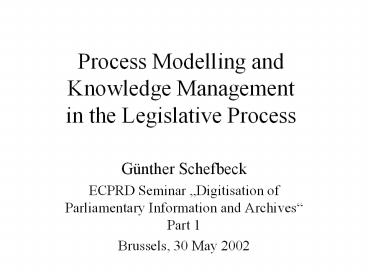Process Modelling and Knowledge Management in the Legislative Process - PowerPoint PPT Presentation
Title:
Process Modelling and Knowledge Management in the Legislative Process
Description:
Process Modelling and Knowledge Management in the Legislative Process G nther Schefbeck ECPRD Seminar Digitisation of Parliamentary Information and Archives Part 1 – PowerPoint PPT presentation
Number of Views:139
Avg rating:3.0/5.0
Title: Process Modelling and Knowledge Management in the Legislative Process
1
Process Modelling and Knowledge Managementin the
Legislative Process
- Günther Schefbeck
- ECPRD Seminar Digitisation of Parliamentary
Information and Archives Part 1 - Brussels, 30 May 2002
2
A legal enactment ... traditional style
3
Legislative Processes
- Complex and multi-layered
- Highly formalized legal procedure
- (going back to 19th century)
- vs.
- Informal political decision-making process
(semi-structured or negotiation process) - Interaction of political and legal layers
4
The value of legislative processes
- A business process is a collection of activities
that takes one or more kinds of inputs and
creates an output that is of value to the
customer (Hammer Champy) - What is the value of a law?
5
The value of laws
- Individual law quality of content
- Rule of law quality of justice
- (Aristotle Under the rule of law the chances
for justice are better than under the rule of
men) - Law produced in a democratic process quality of
legitimation - (Luhmann legitimization by procedure)
6
Rule of law in a democratic system
- Knowledge of laws as a prerequisite for
acceptance of laws and law enforcement - Transparency of the legislative process as a
prerequisite for the acceptance of this process
and its output - Crucial function of publicity of laws and
legislative processes
7
Transparency and democracy
- Means of parliamentary transparency
- public access to (plenary!) meetings
- media coverage
- print documentation
- are as young as democracy (or even younger early
19th century) and - have been given a new quality through the NICT in
the 1990s
8
The IT impact
- 1970s law documentation (mainframes)
- 1980s documentation of legislative processes
(mainframes PCs) - 1990s electronic availability of data (metadata,
full texts of documents, audio/video streaming)
to the general public (PCs Internet) - Today electronification of legislative
processes - Tomorrow ?
9
Legislative processes and E-business/government
functions
- Information
- Communication
- Transaction
- Communication and transaction functions have been
made large-scale available through the Internet
and Intranet applications
10
Five steps of electronic support of legislative
processes
- Knowledge management
- Workflow management
- Improving the procedural quality
- Improving the output quality
- Improving the participatory quality
11
Process modelling
- Knowledge management descriptive modelling
(reduction of complexity) - Workflow management descriptive/prescriptive
modelling (complex legal and administrative
procedure) - Future development prescriptive
modelling/process re-engineering (changing the
legislative process, e.g. by introducing new
instruments/steps)?
12
Present situation functional variety
- Plain information systems
- Mixed systems combining information with aspects
of communication/transaction - Fully electronic workflow systems
13
Present situation organizational variety
- Isolated systems of single parliamentary chambers
- Overall systems of (bicameral) Parliaments
- Integrated systems of all organs involved in the
legislative process
14
Example Switzerland (1)
- Workflow system introduced in 1998
- Electronic production of all legislative
documents - System and format breach Parliament
- Authenticity paper document
15
Example Switzerland (2)
- Functional view electronic workflow system with
derived information function, parliamentary
information and production systems - Organizational view government system,
Parliament involved as a black box
16
Example Austria (1)
- Workflow system operational since 1 January 2002
- Electronic production and transfer of all
legislative documents - System (but not format) breach Parliament
- Authenticity paper document/at least as to
publication from 1 January 2003 on electronic
document
17
Example Austria (2)
- Functional view electronic workflow system,
governmental section using the existing Legal
Information System as archival system,
parliamentary section based on the existing
Parliamentary Documentation System - Organizational view separated government and
Parliament systems with interfaces
18
Example Austria (3-5)
Way of federal legislation (simplified
organizational view)
Federal Minister
Federal Government
Parliament
Federal President
Federal Chancellor
19
Process steps
Legal enactment
Government bill
Proposal to the Council of Ministers
Authentication
LIS
Consultation
Publication
Federal Minister
Federal Government
Parliament
Federal President
Federal Chancellor
20
Electronic workflow system
LIS
Federal Minister
Federal Government
Parliament
Federal President
Federal chancellor
21
Improving the procedural quality
- Process modelling makes aware of capability of
improvement - Necessary amendment of rules of procedure (shift
of paradigm towards autheticity of electronic
documents) gives opportunity to improve procedures
22
Improving the output quality
- Legimatic systems for improving the formal
quality of laws (checking the implementation of
or implementing guidelines for legislation) - Impact assessment and simulation systems for
improving the material quality of legislation
23
Improving the participatory quality
- Already emerging standard solution introducing
new communication tools into the representative
system - Dichotomy indirect vs. direct democracy?
- Visionary concepts for intermediate democracy
models the discussion is opened































